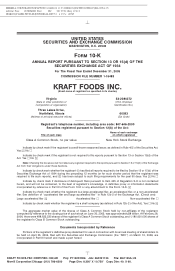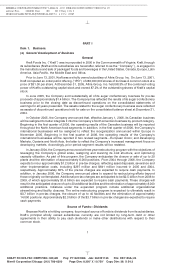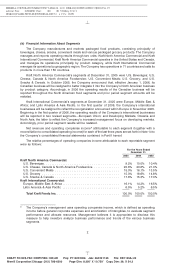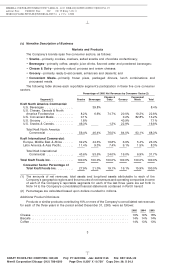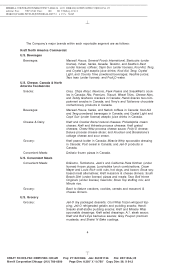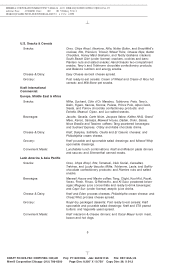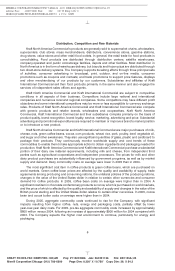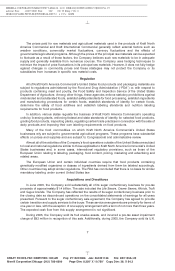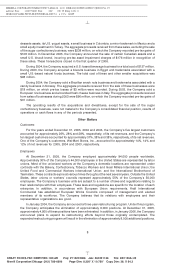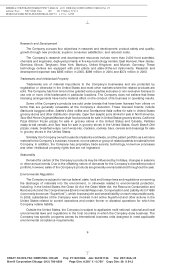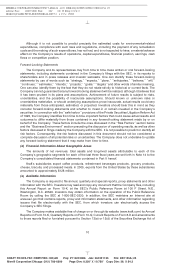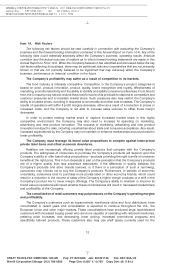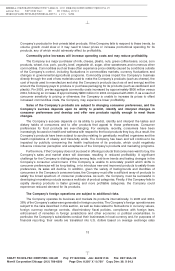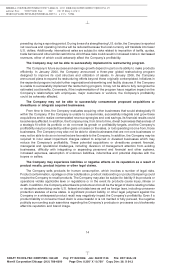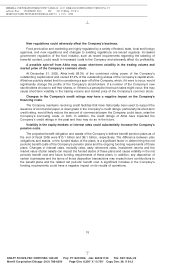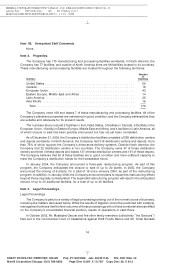Kraft 2005 Annual Report Download - page 7
Download and view the complete annual report
Please find page 7 of the 2005 Kraft annual report below. You can navigate through the pages in the report by either clicking on the pages listed below, or by using the keyword search tool below to find specific information within the annual report.
MERRILL CORPORATION MBLOUNT// 9-MAR-06 14:03 DISK126:[06CHI5.06CHI1135]DE1135A.;25
mrll.fmt Free: 110D*/300D Foot: 0D/ 0D VJ RSeq: 6 Clr: 0
DISK024:[PAGER.PSTYLES]UNIVERSAL.BST;51
KRAFT FOODS-FSC CERTIFIED-10K/AR Proj: P1102CHI06 Job: 06CHI1135 File: DE1135A.;25
Merrill Corporation/Chicago (312) 786-6300 Page Dim: 8.250 X 10.750Copy Dim: 38. X 54.3
Distribution, Competition and Raw Materials
Kraft North America Commercial’s products are generally sold to supermarket chains, wholesalers,
supercenters, club stores, mass merchandisers, distributors, convenience stores, gasoline stations,
drug stores, value stores and other retail food outlets. In general, the retail trade for food products is
consolidating. Food products are distributed through distribution centers, satellite warehouses,
company-operated and public cold-storage facilities, depots and other facilities. Most distribution in
North America is in the form of warehouse delivery, but biscuits and frozen pizza are distributed through
two direct-store delivery systems. The Company supports its selling efforts through three principal sets
of activities: consumer advertising in broadcast, print, outdoor, and on-line media; consumer
promotions such as coupons and contests; and trade promotions to support price features, displays
and other merchandising of our products by our customers. Subsidiaries and affiliates of Kraft
International Commercial sell their food products primarily in the same manner and also engage the
services of independent sales offices and agents.
Kraft North America Commercial and Kraft International Commercial are subject to competitive
conditions in all aspects of their business. Competitors include large national and international
companies and numerous local and regional companies. Some competitors may have different profit
objectives and some international competitors may be more or less susceptible to currency exchange
rates. Products of Kraft North America Commercial and Kraft International Commercial also compete
with generic products and retailer brands, wholesalers and cooperatives. Kraft North America
Commercial, Kraft International Commercial and their subsidiaries compete primarily on the basis of
product quality, brand recognition, brand loyalty, service, marketing, advertising and price. Substantial
advertising and promotional expenditures are required to maintain or improve a brand’s market position
or to introduce a new product.
Kraft North America Commercial and Kraft International Commercial are major purchasers of milk,
cheese, nuts, green coffee beans, cocoa, corn products, wheat, rice, pork, poultry, beef, vegetable oil,
and sugar and other sweeteners. They also use significant quantities of glass, plastic and cardboard to
package their products. They continuously monitor worldwide supply and cost trends of these
commodities to enable them to take appropriate action to obtain ingredients and packaging needed for
production. Kraft North America Commercial and Kraft International Commercial purchase a substantial
portion of their dairy raw material requirements, including milk and cheese, from independent third
parties such as agricultural cooperatives and independent processors. The prices for milk and other
dairy product purchases are substantially influenced by government programs, as well as by market
supply and demand. Dairy commodity costs on average were lower in 2005 than in 2004.
The most significant cost item in coffee products is green coffee beans, which are purchased on
world markets. Green coffee bean prices are affected by the quality and availability of supply, trade
agreements among producing and consuming nations, the unilateral policies of the producing nations,
changes in the value of the United States dollar in relation to certain other currencies and consumer
demand for coffee products. In 2005, coffee bean costs on average were higher than in 2004. A
significant cost item in chocolate confectionery products is cocoa, which is purchased on world markets,
and the price of which is affected by the quality and availability of supply and changes in the value of the
British pound sterling and the United States dollar relative to certain other currencies. In 2005, cocoa
bean and cocoa butter costs on average were higher than in 2004.
During 2005, aggregate commodity costs continued to rise for the Company, with significant
impacts resulting from higher coffee, nuts, energy and packaging costs, partially offset by lower
year-over-year dairy costs. For 2005, pre-tax aggregate commodity costs increased by approximately
$800 million versus 2004, following an increase of approximately $900 million for 2004 compared with
2003. The Company expects the higher cost environment to continue, particularly for energy and
packaging.
6
6 C Cs: 62693

